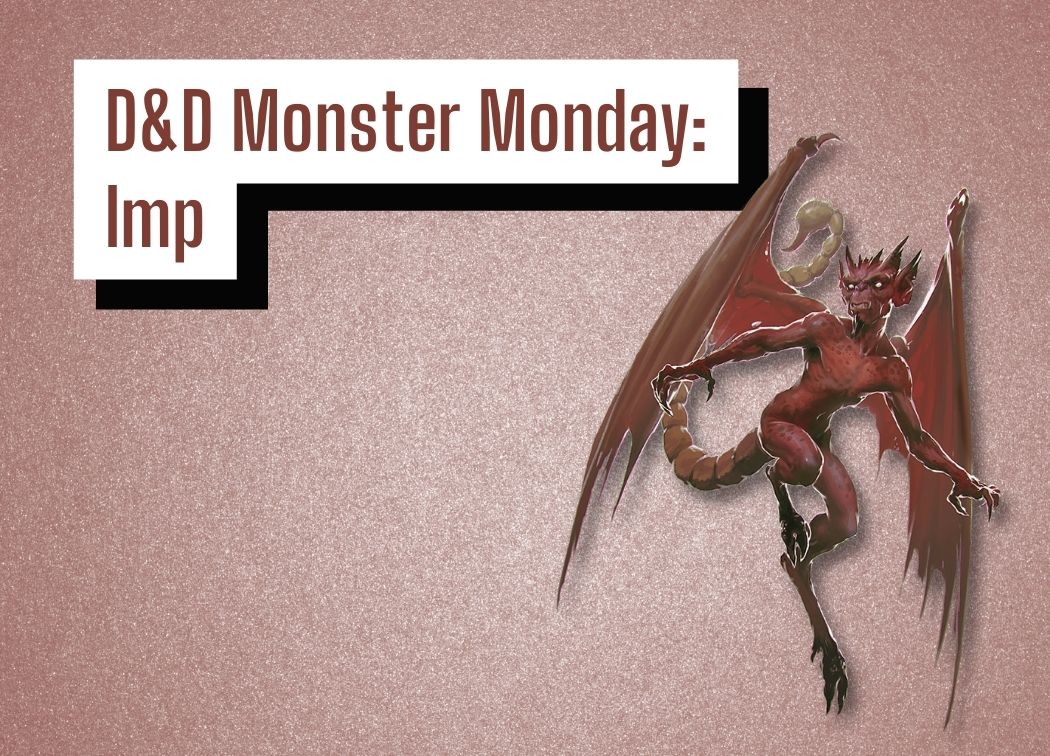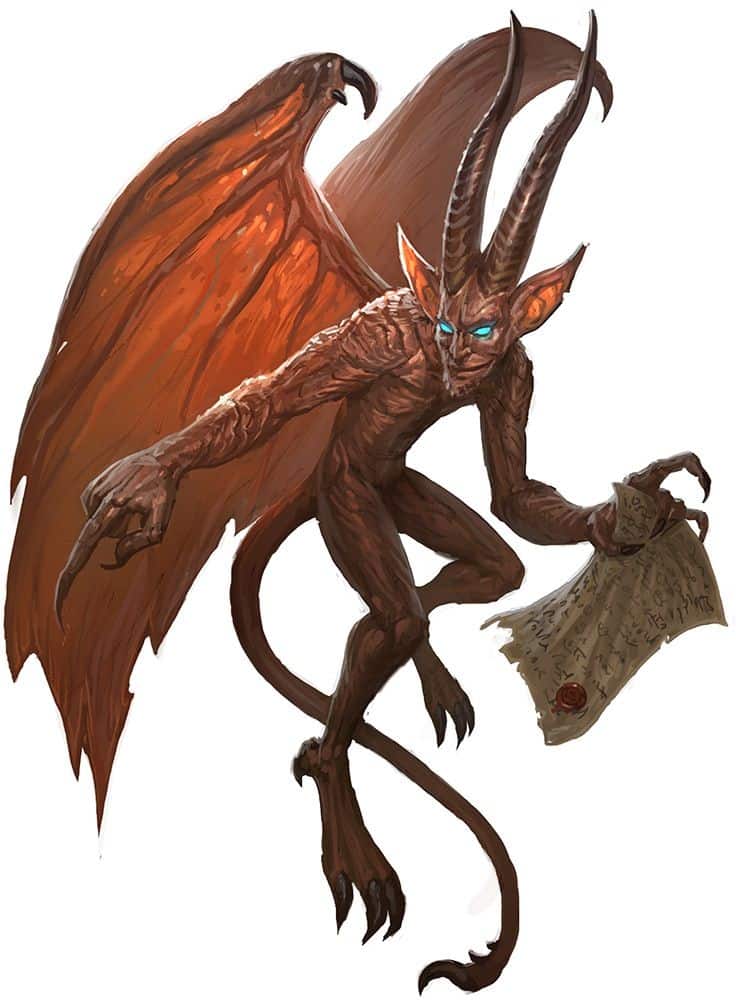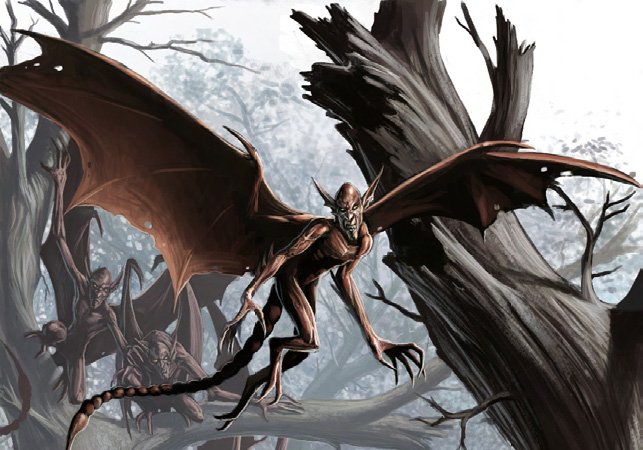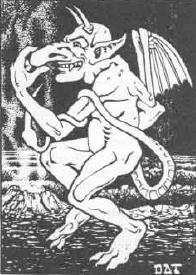D&D Monster Monday: Imp

“What the hell?” you exclaim after a rat bites your leg. You stumble a few steps ahead and then feel your legs give out. “How could a rat…?” you question as you begin to pass out from the pain. In your fading vision, you can see the rat transform into a tiny, red, devil-like creature. Another innocent life was taken by the trickery of an imp!
I had to do a bit of research on a few different creatures for the article on familiars that I wrote last week. So needless to say, I felt that picking one of them for the next Monster Monday would be an appropriate decision.
The imp is an interesting creature. For a CR 1 creature, they can pack one hell of a punch. They also have a ton of interesting traits and abilities at their disposal. This combination makes them both dangerous to low-level adventures in combat encounters, and creatures capable of being useful even outside of combat.
They’re fun creatures, and in turn, spectacular familiars if you can put up with their unique demands.
With that being said, let’s descend into the Monster Manual and learn all about every devil’s favorite minion, the imp!

Imp Lore
Imps are sort of the lowest of the low in terms of the devil hierarchy in the Nine Hells even below the lowly footsoldiers, the merregon. An imp’s existence revolves around serving a master. They’ll run errands, spy on the master’s enemies, or slay some lowly mortals in their master’s name.
But as I said, imps are the lowest of the low. They’re not trusted to complete an important or time-sensitive task. They’re given the tasks that sit at the very bottom of their master’s devilish to-do list.
The life of an imp sucks. You’re bossed around by a powerful devil and given all the dumb tasks that no other devil wants to do.
Well, that is unless you can form a bond with a mortal spellcaster. Then you have a bit of power and can even leave the Nine Hells! They are excellent advisors and spies as a companion to a wizard or other spellcaster.
However, due to their devilish nature, imps are well-known for manipulating their spellcasting masters with feeble wills. Despite the manipulation, imps are fiercly loyal provided that their master continues to follow the contract the two agreed upon!
Imp Stats and Abilities
You can find the imp’s statblock on page 76 of the Monster Manual.
Stats
Size: Tiny fiend (devil)
AC: 13 (Natural Armor)
HP: 10 (3d4 + 3)
Speed: 20 ft., fly 40 ft.
STR: 6 (-2)
DEX: 17 (+3)
CON: 13 (+1)
INT: 11 (+0)
WIS: 12 (+1)
CHA: 14 (+2)
Their 13 AC is certainly mediocre, but it’s even worse when you consider the fact that imps only have 10 HP. They’re easy to hit, and they don’t have a decent-sized health pool to keep them in the fight for long.
They’re quick for a tiny creature. 20 ft. of base movement speed is decent for a tiny creature, but the 40 ft. of flying speed just takes the cake! Unfortunately, they’re still a creature with only melee attack options so this flying speed doesn’t do much for them in terms of survivability.
Their ability scores are damn great for a CR 1 creature. Their only glaring issue is Strength which has a -2 modifier, but it’s such a rare ability score to use for saving throws that this isn’t much of an issue. Especially when they have a +3 Dexterity modifier as a trade-off!
Resistances, Immunities, Saves, and Skills
Skills: Deception +4, Insight +3, Persuasion +4, Stealth +5
Damage Resistance: Cold; Bludgeoning, Piercing, and Slashing from nonmagical attacks that aren’t silvered.
Damage Immunities: Fire, Poison
Condition Immunities: Poisoned
Senses: darkvision 120 ft., passive Perception 11
Languages: Infernal, Common
Challenge: 1 (200 XP)
Holy Nine Hells there’s a lot to unpack here!
I know I’ve said this before, but I love when creatures get a couple/a few skill proficiencies. As a potential familiar, it makes sense that they’d give imps a bit extra out of combat utility, but still, I wish more creatures had these kinds of perks as it gives them viability outside of just combat.
Imps have some of the best damage resistances and immunities in the game. All of these damage types are extremely common for PCs to have. They’re covered by all low-level martial attacks, and they have resistance or immunity to damage from most arcane Cantrips giving them fantastic protection from low-level spellcasters.
Obviously, if they have immunity to poison damage, they have immunity to the poisoned condition. That’s just how life works.
They have some impeccable sight what with 120 ft. of darkvision, but it’s actually enhanced darkvision due to their Devil’s Sight! They make spectacular watchdogs thanks to this heightened darkvision despite only having 11 passive Perception.
Honestly, their CR might be a tad low, but this is a difficult creature to balance. They have the potential to be an offensive wrecking ball, excessive amounts of utility, but absolutely terrible survivability. They’re somewhere between CR 1 and CR 2 for sure though.
Abilities and Traits
Shapechanger. The imp can use its action to Polymorph into a beast form that resembles a rat (speed 20 ft.), a raven (20 ft., fly 60 ft.), or a Spider (20 ft., climb 20 ft.), or back into its true form. Its Statistics are the same in each form, except for the speed changes noted. Any equipment it is wearing or carrying isn’t transformed. It reverts to its true form if it dies.
Devil’s Sight. Magical Darkness doesn’t impede the imp’s darkvision.
Magic Resistance. The imp has advantage on Saving Throws against spells and other magical effects.
Shapechanger has specific wording that we need to dissect first and foremost. Note that the imp is not casting Polymorph the spell. They are simply transforming themselves into something that resembles one of those three creatures.
Why is this important? Because with Polymorph, you are essentially given a secondary health pool that the enemy has to take out before they can deal damage to you in your true form. For the imp, any damage you deal to them when they’re in a Shapechanger form will be dealt directly to their base HP.
Regardless, it is a cool ability that has quite a few uses. They can, of course, hide in plain sight in one of these forms. However, they can also gain different types of movement such as the spider’s climb speed or give themselves some additional flying speed by turning into a raven. There’s a ton of utility in this ability.
Devil’s Sight is a common trait that most devils share. It’s a bit niche, but it’s handy when an enemy spellcaster drops Darkness on top of your imps and they can just shrug it off. There’s not much that can impede an imp’s impeccable vision.
Magic Resistance is always a fantastic trait to have. Imps are both great familiars and excellent anti-magic creatures thanks to their various damage resistances and immunities as well as Magic Resistance.
It makes sense too. If you’re going to work with a spellcaster, you’ll want tools to defeat the spellcaster if they betray you.
Actions
Sting (Bite in Beast Form). Melee Weapon Attack: +5 to hit, reach 5 ft ., one target. Hit: 5 (1d4 + 3) piercing damage, and the target must make on a DC 11 Constitution saving throw, taking 10 (3d6) poison damage on a failed save, or half as much damage on a successful one.
Invisibility. The imp magically turns invisible until it attacks, or until its Concentration ends (as if concentrating on a spell). Any equipment the imp wears or carries is invisible with it.
Sting or Bite if the imp is in a beast form is the imp’s only attack. They don’t have Multiattack, but the damage that Sting/Bite does more than makes up for this. It can deal a base of 5 piercing damage and up to 10 additional poison damage in the target fails the DC 11 Constitution saving throw.
What makes Sting/Bite really powerful is that the target takes half damage on a successful saving throw. Many of these bonus damage effects are “all or nothing” type effects, especially for low CR creatures like the imp. Imps don’t mess around, and with +5 to hit they have a solid chance of hitting you.
Invisibility is rad as hell though. This allows them to open up on the party with an ambush with relative ease. They only have one attack per turn, so they may as well roll it with advantage whenever they get the chance to.
Invisibility is spectacular outside of combat as well. Imps are master scouts and spies for their masters thanks to their impeccable vision, flying speed, and invisibility. Plus they have +5 to Stealth checks so it’s going to be hard to pick an imp out with or without their Invisibility.

Imp Strengths
Devastating Damage
An average of 15 damage in a single attack is a massive blow for a CR 1 creature. That’s a life-threatening amount of damage for a low-level adventurer.
Sting/Bite also deals two different types of damage in its attack so it’s not likely for a PC to have resistance or immunity to both piercing and poison damage. This is basically guaranteed damage, especially since the target takes half damage on a successful save against the poison damage.
Keep in mind that with Invisibility and possibly Shapechanger an imp can strike with advantage, and they can do this regularly. If the player is surprised by your imp ambushing them using this tactic the imp could even gain a whole surprise round.
This maneuver does take an extra round to set up due to both abilities costing an action to use, so it won’t always be ideal to do this in the middle of combat. However, if you get the opportunity to it could be well worth the investment to use Invisibility to regain your bearings and then strike again when the time is right.
Bane of Spellcasters
Imps have resistance to cold damage and immunity to fire and poison damage. In total, that makes 8 of the damage dealing Cantrips either completely useless or half as effective as they typically would be.
This is important since as a CR 1 creature, imps are ideal creatures to throw at low-level adventurers. Low-level adventurers don’t have many spell slots so they’re going to generally throw Cantrips at their enemies and save their spell slots when possible.
Not only that, but Magic Resistance makes it difficult for imps to be targeted by spells that require any kind of saving throw. Plus, their solid ability score array aids them further in succeeding on such saving throws.
Tons of Utility and Mobility
The imp is the perfect scout, which is understandable since that’s one of their primary duties in the Nine Hells. It’s going to be a challenge to spot a hidden imp between their ability to turn themselves invisible at-will and their +5 to Stealth checks.
They have four skill proficiencies which is a ton for a creature. They’re also perfect skills for a devil to have proficiency in. Deception, Insight, and Persuasion make a perfect mix for any sort of manipulative character which devils most certainly are.
In their true form, they have 40 ft. of flying speed which is already solid for scouting or avoiding dangerous melee combatants. However, they can use their Polymorph ability to change into creatures with 60 ft. of flying speed or 20 ft. of climbing speed. Imps can thrive in many different kinds of terrain thanks to this.
Last but not least, I think we should touch on their god-like vision. They have 120 ft. of darkvision which is already phenomenal, but couple that with Devil’s Sight and there’s not much that will get past a vigilant imp.
Imp Weaknesses
Abysmal HP
Interestingly, imps have a ton of traits and features that bolster their survivability. Unfortunately, when push comes to shove all the resistances, immunities, and Magic Resistance in the world can’t save you from a health pool that has a total of 10 HP.
If the party isn’t fazed by the imp’s poison and fire damage immunities, they’ll clean up a handful of imps quickly.
Imps aren’t the kind of creature you’d throw at a party of level 1’s either, it’s a very real possibility that they’ll straight-up murder a 1st-level adventurer without much of an issue. A party of level 2’s or 3’s won’t have an issue cleaning up 10 hp, even if it’s protected by some fantastic resistances and immunities.
An imp doesn’t have the AC to protect themselves from the party’s unrelenting assault, even if they have the damage resistances and immunities to lessen the impact of their blows.
If an imp wants to lay a smackdown on a target they’re going to need to go first or early in the initiative order. Thankfully they have +3 to their initiative rolls, but still, their HP doesn’t do them any favors.
How to Play an Imp
Invisibility, Invisibility, Invisibility!
Invisibility is a key part of the imp’s kit. You can use it to ambush enemies, spy on friends or foes, and even use it to escape a hairy situation.
The downside to Invisibility, though, is that since it requires an action to use it, you’re going to have to plan ahead of time to get the most out of it. Using it at the wrong time will cost you a turn, and with 10 hp, you probably only have one or two good turns up your sleeve.
Attacking from Invisibility will give your Sting/Bite advantage on the attack. This is important since imps don’t have Mulitattack, so any advantage or bonus they can get to hit is valuable. If you can swing it mid-combat I’d certainly recommend going invisible just to get that sweet, sweet advantage.
Leaning on Invisibility is crucial to your imp’s success in whatever goal they have in mind. Think tactically because they may only have one or two shots.
Strike Hard and Get the Hell Out!
Burst out of invisibility and lay the smackdown on the weakest looking target. You want to drop your enemies quick and leave even quicker.
Essentially, an imp will Sting/Bite their enemy and the enemy will drop unconscious. In this scenario, your imp has the perfect opening to use their 40 ft. of flying speed to get away without worrying about opportunity attacks.
Your imps don’t have a lot of HP. They cannot afford to take opportunity attacks. Don’t duck and weave through combat if it’s going to mean you need to risk taking a few opportunity attacks. Try to drop a nearby enemy unconscious then fly away when you’re safe from harm.

Imps as a Familiar
Variant: Familiar. The imp can enter into a contract to serve another creature as a familiar, forming a Telepathic Bond with its willing master. While the two are bonded, the master can sense what the imp senses as long as they are within 1 mile of each other. While the imp is within 10 feet of its master, the master shares the imp’s Magic Resistance trait. If its master violates the terms of the contract, the imp can end its service as a familiar, ending the Telepathic Bond.
Like other variant familiars, imps require a bond between themselves and their masters to be upheld or else they will leave. Imps, however, require their masters to agree to a specific contract. This details rules and regulations that must be upheld for the tenure of their business relationship. It’s not easy to go into business with a devil!
Despite that, imps are popular choices for familiars for spellcasters that are brave enough to agree to a contract with them. In doing so, the spellcaster will forego some of the beneficial aspects of Find Familiar, but they’ll gain a permanent, enhanced familiar that can do some cool stuff.
Imps, for starters, will give their masters Magic Resistance, plus you can utilize all of the imp’s unique traits and abilities such as Shapechanger and Invisibility making them fantastic scouts for your party.
Pact of the Chain Warlocks can have an imp familiar outright. This familiar gains the benefits of Find Familiar that most variant familiars lose out on. Not only that, but Pact of the Chain Warlock familiars can even make attacks! Imps are fantastic familiars already, but the enhanced Pact of the Chain version is on another level.
5 Imp Plot Hooks
- A Pact with a Devil: A local farmhand belives that they have made a pact with what they beleive to be a powerful devil. They have been bullying the local peasants with their newfound powers.
- Scouting The Entrance: The entryway to the Nine Hells was recently breached. Devils have retreated further away from this point, but many imps were sent to scout out the damage and who is invading their homeland.
- Finding a Familiar: The party’s naive wizard belives that they can find, capture, and bond with an imp and make it their new companion. You owe your wizard a big favor, so I guess you’re getting roped into this disaster!
- Keeping an Eye on You: You messed up. Royally. Now Asmodeus has sent a trusted imp to watch over your every move. Don’t fail him a second time!
- A Poor Wager: A local gambling addict accidentally made a deal with a devil and lost. They’re paying (and begging) for any adventurer to come and cleanse this horde of imps from their village!
Conclusions
Imps are certainly powerful creatures. They absolutely strike above their CR 1 belt, but they have plenty of downsides to them to balance them out. They’re also a multi-purpose creature which is fantastic from a DM’s point of view.
Imps are absolutely glass cannons. They can pack a punch, but not take it. Plus they don’t have any ranged attack options to allow them to make the most out of their flying speed. However, these setbacks make for an interesting playstyle for the imp. One that relies on stealth and surprise.
An imp can make for a powerful ally as they have some of the best perks when they’re used as a variant familiar. However, they’re very tricky to deal with. They’re manipulative and have a set of rules that the spellcaster must follow lest their bond is broken.
Imps a fantastic introduction to new players on how devils operate. They’re not like demons who will smack you head-on and are looking to cause trouble. In general, devils are manipulative, devastating, but have specific goals and rules in mind.
